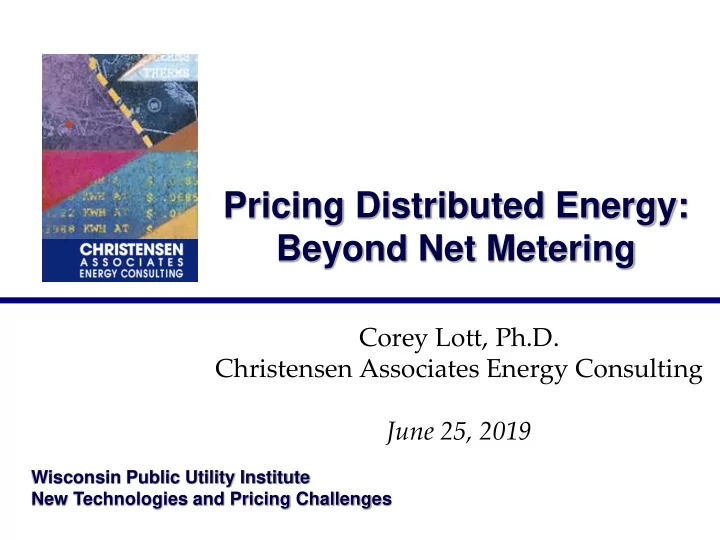

Pricing Distributed Energy: Beyond Net Metering Corey Lott, Ph.D. Christensen Associates Energy Consulting June 25, 2019 Wisconsin Public Utility Institute New Technologies and Pricing Challenges
The Net Metering Dilemma
Net Metering Defined “Net metering is a billing mechanism that credits solar energy system owners for the electricity they add to the grid.”* Uses a utility’s standard tariff and current metering technology Net Energy Metering (NEM) measures net consumption of Distributed Energy Resource (DER) customers DER customers credited at the standard tariff energy price *Solar Energy Industries Association: https://www.seia.org/initiatives/net-metering 3
Rate Design and Utility Costs Standard Tariff = Customer Charge + Energy Charge Fixed Costs vs. Variable Costs Utility costs vary by month, day, hour Example Standard Tariff: Customer Charge: $12 /customer-month Energy Charge: $0.12 /kWh Typical Customer: 1,000 kWh DER Customer: 400 kWh (produces 600 kWh) 4
Net Metering Basics Net Metering at Retail Rate Bill $ $132 $60 $12 Usage (kWh) 1,000 400 5
Net Metering Appears to Create a New DER Customer Class “Net zero” DER customers would show up on the y axis * * ** ** * * * 6
Residential Costs, Prices and Utility Revenue Requirements Price Cost Bill $ $132 Standard Tariff Customer: Revenue = Cost Customer- Related DER Cost DER Revenue Unit Cost Customer Charge $12 400 1,000 kWh/month DER Customer Standard Tariff Customer 7
Net Metering Credit Alternatives for Net Excess Generation (NEG) Net Metering with Net Metering with Credit at Retail Rate for NEG Avoided Cost-Based Credit for NEG Bill $ Bill $ $132 $132 $60 $60 $12 $12 400 1,000 Usage (kWh) 400 1,000 Usage (kWh) 8
Alternatives to Net Metering
“Buy -All/Sell- All” Metering: Requires two meters Can be hourly or monthly usage collected Billing: All site consumption is purchased from the utility at the standard energy charge All site generation is sold to the utility at a separate price (more on this later) The bill is the sum of these two totals 10
Net Metering and Buy-All/Sell-All with Avoided-Cost Based Credit Net Metering Buy-All/Sell-All Credit on NEG Credit on all Site Generation Bill $ Bill $ $132 $132 $102 $60 $60 $12 $12 400 400 1,000 Usage (kWh) 1,000 Usage (kWh) 11
Residential Demand Charges Metering (2 approaches): 1) Meter capable of recording total usage and max demand 2) Use hourly interval metering to record net flows each hour Billing: Charge for net energy consumption Charge for demand via highest net flow value Issue: Is energy price close to avoided cost? 12
Residential Demand Charge with DER Energy Price Cost Bill $ $132 Standard Tariff Customer: Revenue = Cost Customer + Demand DER Cost DER Revenue Charge Customer Charge $12 400 1,000 kWh/month DER Customer Standard Tariff Customer 13
Avoided Cost
Avoided Cost Definition under PURPA*: “the incremental costs to an electric utility of electric energy or capacity or both which, but for the purchase from the qualifying facility or qualifying facilities, such utility would generate itself or purchase from another source.” (18 CFR §292.101(b)(6)) The costs saved by the grid if energy is supplied by an alternative source *Public Utility Regulatory Policies Act, 1978 15
What Costs Are Avoided by DER? Short term Lowers utility generation – Fuel cost – Variable O&M cost Long term Reduced investment in generation capacity Potential reduced investment in transmission/distribution capacity Potential avoided environmental costs What should be included in rate design? 16
Interpretations of Avoided Cost Utility perspective: Costs avoided when demand declines Wholesale market energy and reserves prices Some acceptance: Slower growth in generation capacity Hard to demonstrate T&D savings Wisconsin regulatory review reflects this perspective Result close to wholesale price 17
Interpretations of Avoided Cost (2) Solar/renewable advocate perspective: Expansive view encompassing most long-term costs Value of Solar (VOS) Uses long-term contract offering a quasi-fixed price for up to 25 years (Minnesota) Market price of energy adjusts annually (Austin) Avoided costs re-evaluated with increased penetration Avoided cost estimates up to 30¢/kWh* * Regulatory Assistance Project: Designing Distributed Generation Tariffs Well, Table 10 re VOS Studies 18
Value of Solar Components: Sample Calculation Gross Load Loss Distributed Cost Category Starting Match Savings PV Value Value Factor Factor Avoided Fuel Cost $ 0.061 8% $ 0.066 Avoided Plant O&M - Fixed $ 0.003 40% 9% $ 0.001 Avoided Plant O&M - Variable $ 0.001 8% $ 0.001 Avoided Gen Capacity Cost $ 0.048 40% 9% $ 0.021 Avoided Reserve Capacity Cost $ 0.007 40% 9% $ 0.003 Avoided Trans Capacity Cost $ 0.018 40% 9% $ 0.008 Avoided Dist Capacity Cost $ 0.008 30% 5% $ 0.003 Avoided Environmental Cost $ 0.029 8% $ 0.031 Avoided Voltage Control Cost tbd Solar Integration Cost tbd Value of Solar $ 0.134 Source: Minnesota Value of Solar: Methodology , Clean Power Research, 1/31/2014; Figure 3, p. 42. 19
Replacing Net Metering
Steps in Transition from Net Metering Introduce new metering to obtain needed information Net kWh and kW (Demand Charges) Total kWh in and out (Buy-All, Sell-All) Hourly interval metering (Either, enables TOU) Close enrollment for existing net metering tariff Grandfather existing DER installations into net metering Introduce new DER pricing design to: Fully recover fixed cost Price site generation at a level that is acceptable to all stakeholders 21
Potentially Adequate Designs Buy-all/sell-all: Adequate price incentives Full cost recovery Issue: Reflecting reduced net demand in bills Net billing with demand charges: Full cost recovery Reflects reduced net demand in bills Requires unbundling to make energy price reflect energy-related embedded cost, although not marginal cost 22
Key Issue: Avoided Cost Utility perspective focuses on avoided costs reflected in their books Customer/solar advocate perspective is expansive Calculations in VOS rely on present value of long-run marginal costs Some avoided costs are hotly debated Parties are far apart, limiting ability to compromise 23
Questions? Comments? Please contact Corey Lott at cjlott@caenergy.com 24
Recommend
More recommend